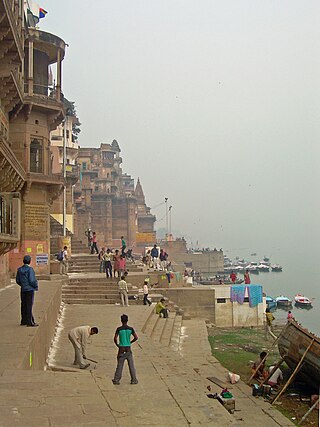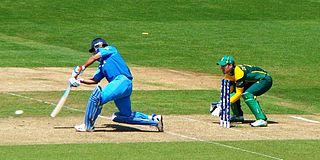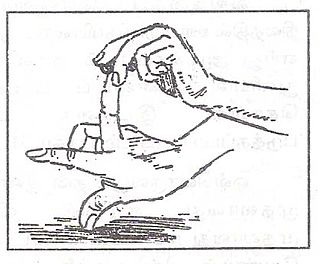
Gilli Danda is an ancient sport originating from South Asia, which is still widely played throughout South Asia. The sport is also found as far north as the Mediterranean and as far east as South East Asia. It was a precusor to cricket in India.

Tag is a playground game involving one or more players chasing other players in an attempt to "tag" and mark them out of play, typically by touching with a hand. There are many variations; most forms have no teams, scores, or equipment. Usually when a person is tagged, the tagger says, "It!" or "Tag, you're 'It'!" The last one tagged during tag is "It" for the next round. The game is known by other names in various parts of the world, including "running and catching" in India and "catch and cook" in the Middle East.

Kho kho is a traditional South Asian sport that dates to ancient India. It is the second-most popular traditional tag game in the Indian subcontinent after kabaddi. Kho kho is played on a rectangular court with a central lane connecting two poles which are at either end of the court. During the game, nine players from the chasing team are on the field, with eight of them sitting (crouched) in the central lane, while three runners from the defending team run around the court and try to avoid being touched. Each sitting player on the chasing team faces the opposite half of the field that their adjacent teammates are facing.

India has a history of sports dating back to the Vedic period. Cricket is the most popular spectator sport; it generates the highest television viewership, with the Indian Premier League (IPL) being the most-followed league in the country. Football has also gained popularity, with the Indian Super League (ISL) being the highest level of domestic football, and the national team winning multiple gold medals at the Asian and South Asian Games. Additional football accomplishments include India having reached the Groupstage of the 1960 Olympics, qualified for the 1950 FIFA World Cup, and won the SAFF Championship. Other sports include kabaddi, badminton, tennis, and athletics, with kho-kho becoming the fourth-most viewed sport. India has also had success in field hockey, winning the World Cup and multiple medals in the Olympic Games. Sports such as golf, rugby, boxing, kickboxing, mixed martial arts, motorsport, wrestling, and basketball are featured throughout the country.

Seven stones is a traditional game from the Indian subcontinent involving a ball and a pile of flat stones, generally played between two teams in a large outdoor area.

Nalugu Stambhalata is a traditional Indian children's game popular in the 1960s and 1970s, when the joint family system flourished in Andhra Pradesh, India.

Nalugu Rallu Aata is a very ancient traditional outdoor four-player game played by the children of the past generation, until the late 1960s and 1980s in many rural districts of Andhra Pradesh State. The origin and the birth of this game is unknown. Today this game has completely vanished due to urbanization and invasion of western games.
Oonch Neech is a rural and urban street children's game and variation of Tag game played in North India and Pakistan. Oonch Neech (Hindi) translates Up and Down in English.

A number of games can be played with marbles.
Many sports are played by the people of Tamil Nadu including both traditional sports and sports from other countries.

Atya patya is a traditional South Asian tag sport played by two sides of nine players. It is more popular in rural areas of India. It is more commonly played in Maharashtra, a western Indian state. Atya patya is described as a "game of feints". The playing area comprises nine trenches, coming out of either side of a central trench; a point is awarded to the attacking team's players for each trench they cross without being tagged out by the defensive players within the trenches. The game ends after 4 innings of 7 minutes each, with each team having two innings to score. It has been described as a game of "militant chase". The sport is played in a relatively small area and requires no equipment, similar to other games indigenous to India such as kabaddi, seven stones, kho kho, gillidanda and langdi.
Sports in Andhra Pradesh has its own importance, where many sporting personalities were into limelight. The Sports Authority of Andhra Pradesh (SAAP) undertakes the sports development activities such as construction of stadiums, establishment of sports academies and other sporting related activities. The sports infrastructure have increased tremendously by improving infrastructure in outdoor and Indoor stadiums, play fields, sports academies, sports equipments etc. Traditional sports such as kho kho, kabaddi are played mostly in Andhra Pradesh.Most sports players from Andhra pradesh represent national level competitions and very few international competitions.
Paandi, also known as Pandi or Nondi, is a regional hopscotch game traditionally played in rural parts of India, Sri Lanka and also in certain other countries with large numbers of immigrant Indians. The game is played only for leisure and does not involve serious rules or regulations. It is also called as Tokkudu Billa or Tangidi Billa in Andhra Pradesh and Kunte Bille in Karnataka

Bengali traditional games are traditional games that are played in rural parts of the historical region of Bengal. These games are typically played outside with limited resources. Many games have similarities to other traditional South Asian games.

India has several traditional games and sports, some of which have been played for thousands of years. Their popularity has greatly declined in the modern era, with Western sports having overtaken them during the British Raj, and the Indian government now making some efforts to revive them. Many of these games do not require much equipment or playing space. Some of them are only played in certain regions of India, or may be known by different names and played under different rules and regulations in different regions of the country. Many Indian games are also similar to other traditional South Asian games.

Pakistan has many traditional games played in the rural and urban areas of the country.

South Asia has many traditional games and sports. Two of them, kabaddi and kho-kho, are played at the South Asian Games, with kabaddi also featuring at the Asian Games. Many of these games are played across the entire subcontinent under different names and with some rule variations, while some of these games may be played only in certain countries or regions.
The Chhattisgarhiya Olympics are an annual sports event held in Chhattisgarh, India to celebrate traditional Indian games such as kabaddi and kho-kho, as well as to promote sports participation among rural people and women. The event takes place over three months. The first edition was held in 2022, with around 2.6 million Chattisgarhis participating, and about 1,900 of them reaching the state-level finals. Over 3 million Chattisgarhis likely participated in the 2023 edition.
Nepal has many traditional games that are similar to other traditional South Asian games. Many of these games were played during local cultural festivals, but are now disappearing because of technological influence and globalisation.












